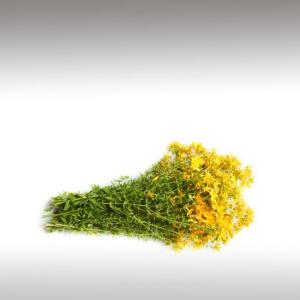
ST JOHNS WORT ESSENTIAL OIL (HYPERICUM PERFORATUM) - ESSENTIAL OILS

BASE / GENERAL DATA
Information submited: April 17, 2015 Modified: April 22, 2018 By: OperaDreamhouse
Botanical Name: Hypericum perforatum
Common Method of Extraction: Steam distilled
Part Typically Used: Flowers
Color: Pale yellow
Consistency: Thin
Perfumery Note: Middle
Strength of Initial Aroma: Soft, herbal, balsamic.
Hypericum Perforatum, known as Perforate St John's-Wort, Common Saint John's Wort and St John's Wort is a flowering plant of the genus Hypericum. Hypericum Perforatum is indigenous to Europe but has spread worldwide as an invasive species, including to temperate and subtropical regions of Turkey, Ukraine, Russia, the Middle East, India, Canada, the United States and China.
The herbs common name comes from its traditional flowering and harvesting on St John's day, 24 June. The genus name Hypericum is derived from the Greek words Hyper (Above) and Eikon (Picture), in reference to the plant's traditional use in warding off evil by hanging plants over a religious icon in the house during St John's day. The species name perforatum refers to the presence of small oil glands in the leaves that look like windows, which can be seen when they are held against the light.
St John's Wort is a perennial plant with extensive, creeping rhizomes. Its stems are erect, branched in the upper section, and can grow to 1 m high. Its flowers measure up to 2,5 cm across, have five petals, and are colored bright yellow with conspicuous black dots. The flowers appear in broad cymes at the ends of the upper branches, between late spring and early to mid summer.
The flowers and stems of the plant have been used to make red and yellow dyes.
Hypericum species are generally classed as essential oil-poorplants (generally oil yield
Common Method of Extraction: Steam distilled
Part Typically Used: Flowers
Color: Pale yellow
Consistency: Thin
Perfumery Note: Middle
Strength of Initial Aroma: Soft, herbal, balsamic.
Hypericum Perforatum, known as Perforate St John's-Wort, Common Saint John's Wort and St John's Wort is a flowering plant of the genus Hypericum. Hypericum Perforatum is indigenous to Europe but has spread worldwide as an invasive species, including to temperate and subtropical regions of Turkey, Ukraine, Russia, the Middle East, India, Canada, the United States and China.
The herbs common name comes from its traditional flowering and harvesting on St John's day, 24 June. The genus name Hypericum is derived from the Greek words Hyper (Above) and Eikon (Picture), in reference to the plant's traditional use in warding off evil by hanging plants over a religious icon in the house during St John's day. The species name perforatum refers to the presence of small oil glands in the leaves that look like windows, which can be seen when they are held against the light.
St John's Wort is a perennial plant with extensive, creeping rhizomes. Its stems are erect, branched in the upper section, and can grow to 1 m high. Its flowers measure up to 2,5 cm across, have five petals, and are colored bright yellow with conspicuous black dots. The flowers appear in broad cymes at the ends of the upper branches, between late spring and early to mid summer.
The flowers and stems of the plant have been used to make red and yellow dyes.
Hypericum species are generally classed as essential oil-poorplants (generally oil yield

SPIRITUAL PRACTISES DATA

MEDICINE / HEALTH DATA

BEAUTY / COSMETICS DATA

FOOD / COOKING DATA
COMMENTS
No comments.


